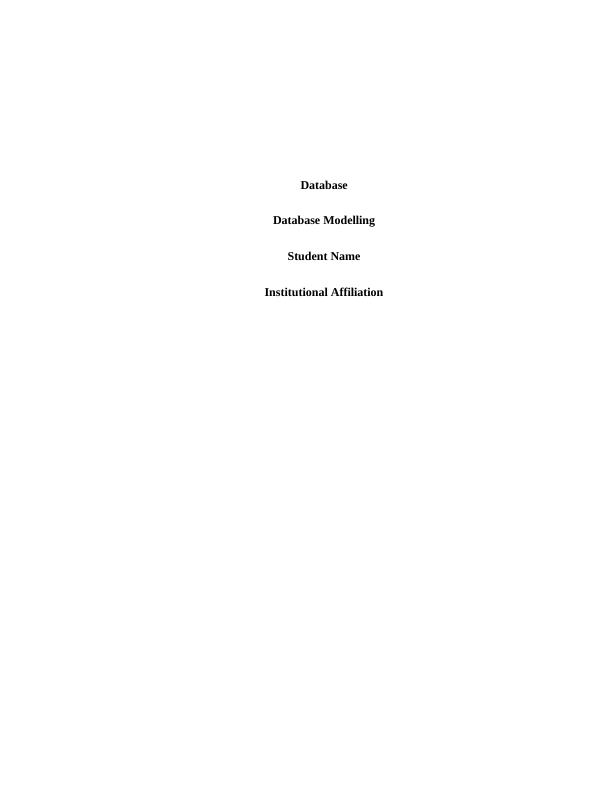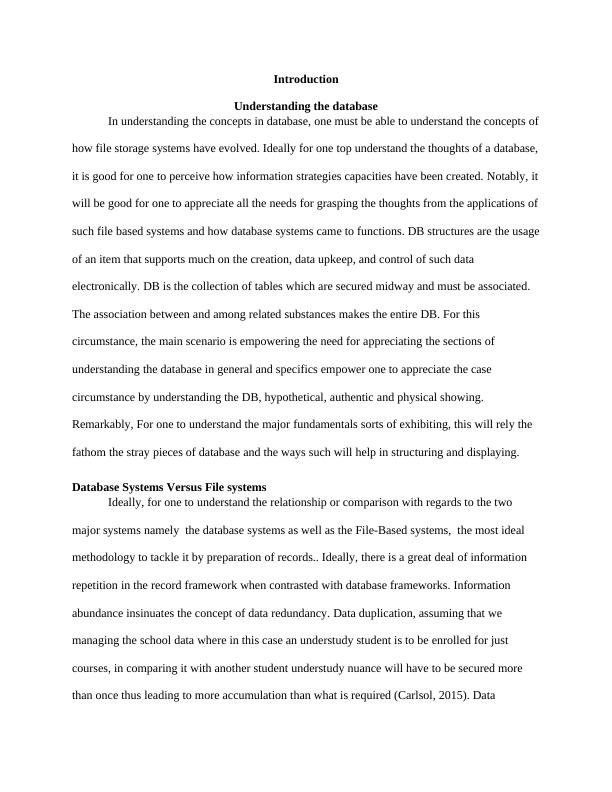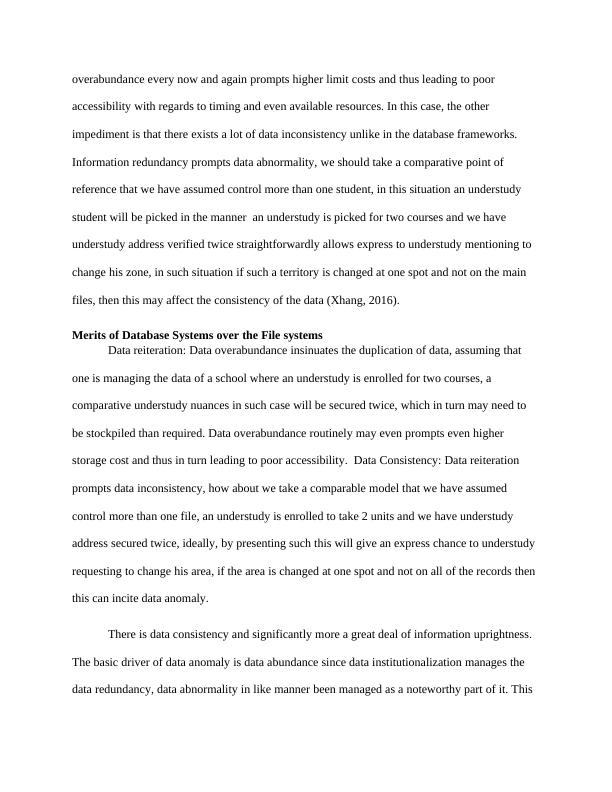Understanding the Database: Concepts and Models
Developing a database for New University
18 Pages2070 Words392 Views
Added on 2023-03-29
About This Document
This document provides an in-depth understanding of database systems, including the concepts and models such as hierarchical, network, and relational models. It discusses the advantages of using database systems over file systems and the disadvantages of using DB systems. The document also covers topics like data normalization, entity relationship diagrams, and data manipulation and definition languages.
Understanding the Database: Concepts and Models
Developing a database for New University
Added on 2023-03-29
ShareRelated Documents
Database
Database Modelling
Student Name
Institutional Affiliation
Database Modelling
Student Name
Institutional Affiliation

Table of Contents
Introduction...............................................................................................................................................3
Understanding the database.....................................................................................................................3
Database Systems Versus File systems.................................................................................................3
Merits of Database Systems over the File systems..........................................................................4
Disadvantages of using DB systems..................................................................................................5
Data Models...........................................................................................................................................5
Hierarchical Model............................................................................................................................5
Network Model..................................................................................................................................6
Relational Model................................................................................................................................7
Top-down Versus Bottom-Up Object DB design.................................................................................8
Top-Bottom Approach......................................................................................................................9
Conceptual Modelling...............................................................................................................................9
Entities....................................................................................................................................................9
Crown’s Foot Notation Design............................................................................................................10
Logical modelling....................................................................................................................................10
Database Normalization......................................................................................................................10
Entity Relationship Diagram..............................................................................................................11
Physical Modelling...................................................................................................................................12
Data Definition Language...................................................................................................................12
Data Manipulation Language.............................................................................................................13
Passenger Table...................................................................................................................................13
Plane Table.......................................................................................................................................13
Employee Table...............................................................................................................................13
Airline Table....................................................................................................................................13
List of References....................................................................................................................................14
Introduction...............................................................................................................................................3
Understanding the database.....................................................................................................................3
Database Systems Versus File systems.................................................................................................3
Merits of Database Systems over the File systems..........................................................................4
Disadvantages of using DB systems..................................................................................................5
Data Models...........................................................................................................................................5
Hierarchical Model............................................................................................................................5
Network Model..................................................................................................................................6
Relational Model................................................................................................................................7
Top-down Versus Bottom-Up Object DB design.................................................................................8
Top-Bottom Approach......................................................................................................................9
Conceptual Modelling...............................................................................................................................9
Entities....................................................................................................................................................9
Crown’s Foot Notation Design............................................................................................................10
Logical modelling....................................................................................................................................10
Database Normalization......................................................................................................................10
Entity Relationship Diagram..............................................................................................................11
Physical Modelling...................................................................................................................................12
Data Definition Language...................................................................................................................12
Data Manipulation Language.............................................................................................................13
Passenger Table...................................................................................................................................13
Plane Table.......................................................................................................................................13
Employee Table...............................................................................................................................13
Airline Table....................................................................................................................................13
List of References....................................................................................................................................14

Introduction
Understanding the database
In understanding the concepts in database, one must be able to understand the concepts of
how file storage systems have evolved. Ideally for one top understand the thoughts of a database,
it is good for one to perceive how information strategies capacities have been created. Notably, it
will be good for one to appreciate all the needs for grasping the thoughts from the applications of
such file based systems and how database systems came to functions. DB structures are the usage
of an item that supports much on the creation, data upkeep, and control of such data
electronically. DB is the collection of tables which are secured midway and must be associated.
The association between and among related substances makes the entire DB. For this
circumstance, the main scenario is empowering the need for appreciating the sections of
understanding the database in general and specifics empower one to appreciate the case
circumstance by understanding the DB, hypothetical, authentic and physical showing.
Remarkably, For one to understand the major fundamentals sorts of exhibiting, this will rely the
fathom the stray pieces of database and the ways such will help in structuring and displaying.
Database Systems Versus File systems
Ideally, for one to understand the relationship or comparison with regards to the two
major systems namely the database systems as well as the File-Based systems, the most ideal
methodology to tackle it by preparation of records.. Ideally, there is a great deal of information
repetition in the record framework when contrasted with database frameworks. Information
abundance insinuates the concept of data redundancy. Data duplication, assuming that we
managing the school data where in this case an understudy student is to be enrolled for just
courses, in comparing it with another student understudy nuance will have to be secured more
than once thus leading to more accumulation than what is required (Carlsol, 2015). Data
Understanding the database
In understanding the concepts in database, one must be able to understand the concepts of
how file storage systems have evolved. Ideally for one top understand the thoughts of a database,
it is good for one to perceive how information strategies capacities have been created. Notably, it
will be good for one to appreciate all the needs for grasping the thoughts from the applications of
such file based systems and how database systems came to functions. DB structures are the usage
of an item that supports much on the creation, data upkeep, and control of such data
electronically. DB is the collection of tables which are secured midway and must be associated.
The association between and among related substances makes the entire DB. For this
circumstance, the main scenario is empowering the need for appreciating the sections of
understanding the database in general and specifics empower one to appreciate the case
circumstance by understanding the DB, hypothetical, authentic and physical showing.
Remarkably, For one to understand the major fundamentals sorts of exhibiting, this will rely the
fathom the stray pieces of database and the ways such will help in structuring and displaying.
Database Systems Versus File systems
Ideally, for one to understand the relationship or comparison with regards to the two
major systems namely the database systems as well as the File-Based systems, the most ideal
methodology to tackle it by preparation of records.. Ideally, there is a great deal of information
repetition in the record framework when contrasted with database frameworks. Information
abundance insinuates the concept of data redundancy. Data duplication, assuming that we
managing the school data where in this case an understudy student is to be enrolled for just
courses, in comparing it with another student understudy nuance will have to be secured more
than once thus leading to more accumulation than what is required (Carlsol, 2015). Data

overabundance every now and again prompts higher limit costs and thus leading to poor
accessibility with regards to timing and even available resources. In this case, the other
impediment is that there exists a lot of data inconsistency unlike in the database frameworks.
Information redundancy prompts data abnormality, we should take a comparative point of
reference that we have assumed control more than one student, in this situation an understudy
student will be picked in the manner an understudy is picked for two courses and we have
understudy address verified twice straightforwardly allows express to understudy mentioning to
change his zone, in such situation if such a territory is changed at one spot and not on the main
files, then this may affect the consistency of the data (Xhang, 2016).
Merits of Database Systems over the File systems
Data reiteration: Data overabundance insinuates the duplication of data, assuming that
one is managing the data of a school where an understudy is enrolled for two courses, a
comparative understudy nuances in such case will be secured twice, which in turn may need to
be stockpiled than required. Data overabundance routinely may even prompts even higher
storage cost and thus in turn leading to poor accessibility. Data Consistency: Data reiteration
prompts data inconsistency, how about we take a comparable model that we have assumed
control more than one file, an understudy is enrolled to take 2 units and we have understudy
address secured twice, ideally, by presenting such this will give an express chance to understudy
requesting to change his area, if the area is changed at one spot and not on all of the records then
this can incite data anomaly.
There is data consistency and significantly more a great deal of information uprightness.
The basic driver of data anomaly is data abundance since data institutionalization manages the
data redundancy, data abnormality in like manner been managed as a noteworthy part of it. This
accessibility with regards to timing and even available resources. In this case, the other
impediment is that there exists a lot of data inconsistency unlike in the database frameworks.
Information redundancy prompts data abnormality, we should take a comparative point of
reference that we have assumed control more than one student, in this situation an understudy
student will be picked in the manner an understudy is picked for two courses and we have
understudy address verified twice straightforwardly allows express to understudy mentioning to
change his zone, in such situation if such a territory is changed at one spot and not on the main
files, then this may affect the consistency of the data (Xhang, 2016).
Merits of Database Systems over the File systems
Data reiteration: Data overabundance insinuates the duplication of data, assuming that
one is managing the data of a school where an understudy is enrolled for two courses, a
comparative understudy nuances in such case will be secured twice, which in turn may need to
be stockpiled than required. Data overabundance routinely may even prompts even higher
storage cost and thus in turn leading to poor accessibility. Data Consistency: Data reiteration
prompts data inconsistency, how about we take a comparable model that we have assumed
control more than one file, an understudy is enrolled to take 2 units and we have understudy
address secured twice, ideally, by presenting such this will give an express chance to understudy
requesting to change his area, if the area is changed at one spot and not on all of the records then
this can incite data anomaly.
There is data consistency and significantly more a great deal of information uprightness.
The basic driver of data anomaly is data abundance since data institutionalization manages the
data redundancy, data abnormality in like manner been managed as a noteworthy part of it. This

End of preview
Want to access all the pages? Upload your documents or become a member.
Related Documents
Database System for Jet Airlineslg...
|19
|2336
|329
Database Design and Implementationlg...
|20
|3051
|345
Data Modelling & SQL Languagelg...
|20
|3087
|444
Database Design and Implementationlg...
|15
|3038
|164
Database Design and Implementationlg...
|15
|3038
|167
Business Process Modelling for Second Hand Book Buying and Sellinglg...
|8
|1896
|344
